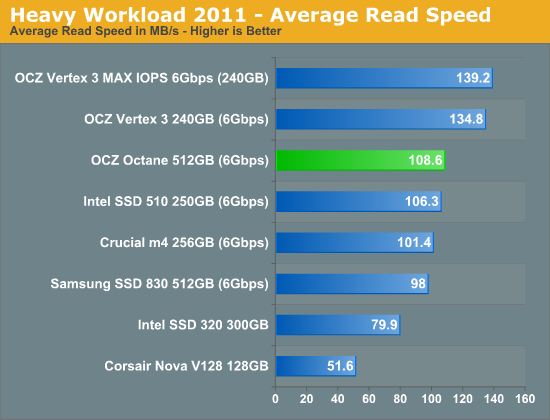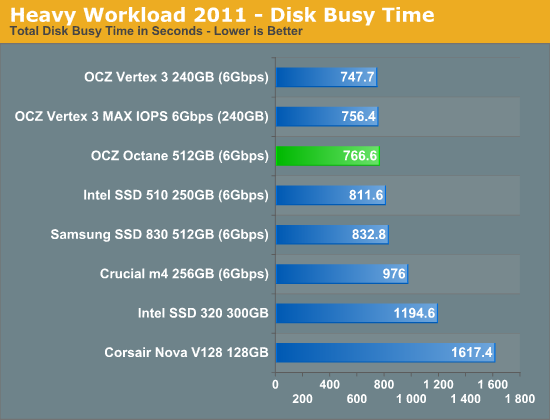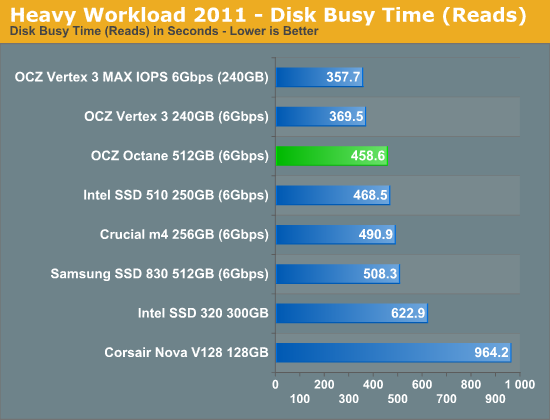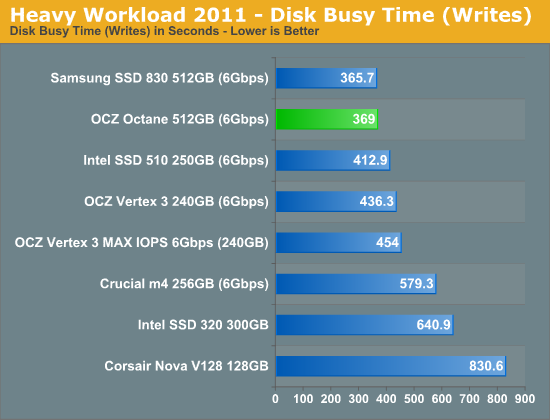The OCZ Octane Review (512GB)
by Anand Lal Shimpi on November 23, 2011 12:00 PM ESTAnandTech Storage Bench 2011
Last year we introduced our AnandTech Storage Bench, a suite of benchmarks that took traces of real OS/application usage and played them back in a repeatable manner. I assembled the traces myself out of frustration with the majority of what we have today in terms of SSD benchmarks.
Although the AnandTech Storage Bench tests did a good job of characterizing SSD performance, they weren't stressful enough. All of the tests performed less than 10GB of reads/writes and typically involved only 4GB of writes specifically. That's not even enough exceed the spare area on most SSDs. Most canned SSD benchmarks don't even come close to writing a single gigabyte of data, but that doesn't mean that simply writing 4GB is acceptable.
Originally I kept the benchmarks short enough that they wouldn't be a burden to run (~30 minutes) but long enough that they were representative of what a power user might do with their system.
Not too long ago I tweeted that I had created what I referred to as the Mother of All SSD Benchmarks (MOASB). Rather than only writing 4GB of data to the drive, this benchmark writes 106.32GB. It's the load you'd put on a drive after nearly two weeks of constant usage. And it takes a *long* time to run.
1) The MOASB, officially called AnandTech Storage Bench 2011 - Heavy Workload, mainly focuses on the times when your I/O activity is the highest. There is a lot of downloading and application installing that happens during the course of this test. My thinking was that it's during application installs, file copies, downloading and multitasking with all of this that you can really notice performance differences between drives.
2) I tried to cover as many bases as possible with the software I incorporated into this test. There's a lot of photo editing in Photoshop, HTML editing in Dreamweaver, web browsing, game playing/level loading (Starcraft II & WoW are both a part of the test) as well as general use stuff (application installing, virus scanning). I included a large amount of email downloading, document creation and editing as well. To top it all off I even use Visual Studio 2008 to build Chromium during the test.
The test has 2,168,893 read operations and 1,783,447 write operations. The IO breakdown is as follows:
| AnandTech Storage Bench 2011 - Heavy Workload IO Breakdown | ||||
| IO Size | % of Total | |||
| 4KB | 28% | |||
| 16KB | 10% | |||
| 32KB | 10% | |||
| 64KB | 4% | |||
Only 42% of all operations are sequential, the rest range from pseudo to fully random (with most falling in the pseudo-random category). Average queue depth is 4.625 IOs, with 59% of operations taking place in an IO queue of 1.
Many of you have asked for a better way to really characterize performance. Simply looking at IOPS doesn't really say much. As a result I'm going to be presenting Storage Bench 2011 data in a slightly different way. We'll have performance represented as Average MB/s, with higher numbers being better. At the same time I'll be reporting how long the SSD was busy while running this test. These disk busy graphs will show you exactly how much time was shaved off by using a faster drive vs. a slower one during the course of this test. Finally, I will also break out performance into reads, writes and combined. The reason I do this is to help balance out the fact that this test is unusually write intensive, which can often hide the benefits of a drive with good read performance.
There's also a new light workload for 2011. This is a far more reasonable, typical every day use case benchmark. Lots of web browsing, photo editing (but with a greater focus on photo consumption), video playback as well as some application installs and gaming. This test isn't nearly as write intensive as the MOASB but it's still multiple times more write intensive than what we were running last year.
As always I don't believe that these two benchmarks alone are enough to characterize the performance of a drive, but hopefully along with the rest of our tests they will help provide a better idea.
The testbed for Storage Bench 2011 has changed as well. We're now using a Sandy Bridge platform with full 6Gbps support for these tests.
AnandTech Storage Bench 2011 - Heavy Workload
We'll start out by looking at average data rate throughout our new heavy workload test:

When put to the test the Octane does not disappoint. It's within a couple MB/s of the SF-2281 based Vertex 3, and effectively one of the fastest 6Gbps drives on the market today. I included the old Indilinx Barefoot based Corsair Nova V128 to show just how far Indilinx has come here.


The next three charts just represent the same data, but in a different manner. Instead of looking at average data rate, we're looking at how long the disk was busy for during this entire test. Note that disk busy time excludes any and all idles, this is just how long the SSD was busy doing something:













75 Comments
View All Comments
iwod - Wednesday, November 23, 2011 - link
So while hopefully pulling Seq Read Write Further until we reach the same point of the curve as Random Write, which should be fairly easy, SSD needs to Significantly improve Random ReadChloiber - Wednesday, November 23, 2011 - link
Anand - why don't you also test Random Read with a queue depth of 32? I agree that QD32 isn't as important as below-10s, but I don't quite understand why there is no QD32 Random Read but a QD32 Random Write?mino - Wednesday, November 23, 2011 - link
NAND 512GBUser Capacity 476GiB
I hope AT staff is aware that:
512GB (GigaByte) == 512*10^9 Bytes == 476*2^30 Bytes == 476 GiB (GibiByte)
If so, then what does "User capacity" mean in that table?
Provided a claimed 7% spare area, "User capacity" would be 512 GB*0.93 = 476.16 GB == 443.5 GiB.
In my humble opinion, the reality is such:
NAND Capacity is 512GiB
User Capacity is 476 GiB (== 512GB)
jwilliams4200 - Wednesday, November 23, 2011 - link
No, a 512GB drive should have 512GB of usable capacity. And the Octane apparently does (as do other 512GB SSDs).It also has 512GiB of flash memory on board.
512GiB / 512GB = 1024^3 / 1000^3 = 1.0737, which is about 7% reserved.
mino - Wednesday, November 23, 2011 - link
Yes, I suggest/expect the same thing.Now, please go and read the table at the beginning of the article which clearly states (as of now):
NAND 1TB 512GB 256GB 128GB
User Capacity 953GiB 476GiB 238GiB 119GiB
;)
jwilliams4200 - Wednesday, November 23, 2011 - link
Anand always gets his GiB / GB wrong. I don't think I have seen him get it entirely right in any article. So I tend to ignore his mistakes now. But you are correct that his NAND flash capacity row is wrong in this article. He wrote "GB" when he should have written "GiB".I was just responding to the line where you said the user capacity is 443.5 GiB (no, it is 476GiB, Anand at least got that right). Anyway, I think we are in agreement.
mino - Friday, November 25, 2011 - link
Yeah.What I do not understand why AT insists on using both GiB and GB in an article and making consistently fools of themselves by using it wrong..
If AT "named" all GiB values in that table as "GB", I would not really bother, as that is a common practice.
What always pisses me off is the smart-ass use of both *B and *iB in the same table while consistently getting it wrong one way or the other.
Why do I bother?
Because this sloppiness puts the important spare area claims into the "maybe, if they did not miscalculate" category...
Avenger762 - Wednesday, November 23, 2011 - link
I'm not sure if the OCZ name is really recovering. I have purchased many of the Vertex 30GB and Vertex 2 40GB drives for workstations in my organization as well as OCZ RAM. I had an ongoing fiasco on getting the RMA'd RAM back. In addition about 10% of the Vertex 30GB's have failed and 2 of the Vertex 2 40GB's that were purchased about 4 months ago just failed today. As soon as my supplier can get a contract with Kingston or SanDisk SSD's, I believe that I will switch over. OCZ was always good for my personal PC, but in large volumes for the organization that I work for, they fall way short.LB-ID - Wednesday, November 23, 2011 - link
...from OCZ's 3-series drives (Vertex, Agility, etc.). They were basically inoperable for a large chunk of their client base, and even after seven months now, although their current firmware is a vast improvement, issues still persist for some. Couple that with the dismissive (and sometimes worse) attitude displayed by their 'customer service', and you have a company with a badly-damaged reputation. I'll be steering clear of them for the foreseeable future, particularly with so many comparably-priced options with far better stability available from their competitors.Beenthere - Wednesday, November 23, 2011 - link
In all honesty OCZ as a company has never impressed me. I never found their tweaked RAM to be all that great. It was a niche product that eventually made them a lot of money when review sites hyped it but the performance gains were really more in benchmarks than in system performance.Then OCZ moved on to PSUs. As history has shown this has been a mixed bag for them too. Lots of QC and design issues from their suppliers didn't help. Then they bought PCPC to try and figure out how to produce quality PSUs. Today they still have a mixed bag of PSUs under the OCZ brand with only PCPCs stuff always be top quality.
Now OCZ is flooding the market with SSDs. Needless to say all SSD suppliers have had issues with the immature tech they have been dumping in the market for naive consumers to gobble up. There has been a pretty high price to pay for being naive and jumping on these half-baked SSDs, especially OCZ's.
It would appear that OCZ is trying to stay one step ahead of the competition with all sorts of variations in SSDs be it SandForce based, Revo or now Octane. This "shotgun approach" may work for sales but as we know, OCZ's SSD quality and compatibility resembles that of their RAM and PSUs... NOT very inspiring.
So the watch word is WAIT and let other folks be UNPAID Beta testers on these half-baked products - as Anand so rightly suggested.